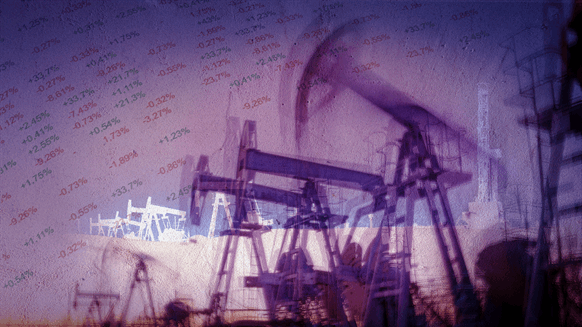Kemp: Feast Or Famine? Oil Market In 2018

Oil consumption is forecast to increase by another 1.4 million bpd in 2018, the IEA says (“Oil Market Report”, IEA, September 2017).
Global crude and product stocks are now drawing down rapidly owing to a combination of strong demand and supply restraint by Saudi Arabia.
Stocks are still above the five-year average, but converging towards it, and the five-year average is likely to prove too low given the prodigious growth in consumption since 2012.
The critical question is how quickly producers will respond to strengthening demand and tightening oil inventories.
With most producers already operating near full capacity, most output growth over the next two years will have to come from Saudi Arabia (and its close ally Kuwait), conflict-torn countries in Africa, or the U.S. shale sector.
Saudi Arabia has spare capacity, but will likely want higher prices before increasing its supply to the market, especially with the partial floatation of Aramco drawing nearer.
Nigeria and Libya also have spare capacity but the poor security situation in both countries makes future production increases highly uncertain.
U.S. shale producers can increase production, but their costs are rising, and they are coming under mounting pressure from shareholders to focus on improving returns rather than growing output.
What Next?
A range of scenarios is possible for the oil market in 2018/19:
- The rise in prices and move to backwardation could fizzle out if compliance with the OPEC production agreement declines and U.S. shale output rises rapidly, overwhelming demand growth.
- Prices and calendar spreads could remain rangebound, if OPEC exits its agreement smoothly and the rise in shale output matches the growth in demand.
- It is at least possible that prices will rise further and the backwardation will deepen if consumption growth outstrips supply and stocks continue to fall.
Many analysts and traders have backward-looking expectations, assuming the future will resemble the immediate past, which is why they tend to miss turning points.
Expectations were much too bullish after the boom years of 2011-2014, which is why many analysts and traders missed the impending slump, and then underestimated its depth and duration.
But it is arguable expectations have become too bearish in the aftermath of the slump and traders are now underestimating the prospects for recovery.
Of course, it’s always possible the market will have just enough supply, with shale and OPEC adjusting smoothly to match the increase in demand.
But if I were advising Pharaoh, I wouldn’t tell him to bet on it.
(Editing by Dale Hudson)
123
View Full Article
WHAT DO YOU THINK?
Generated by readers, the comments included herein do not reflect the views and opinions of Rigzone. All comments are subject to editorial review. Off-topic, inappropriate or insulting comments will be removed.
- Weatherford CEO's Rebound Plan Relies On Getting Smaller
- Iran Says Oil Market Is Too Tight For US Zero Exports Target
- China's Squeezed 'Teapots' Eye Petchem Path To Riches
- Baker Hughes: US Drillers Add Oil Rigs For Second Week In Three
- Venezuela Hands China More Oil Presence, But No Mention Of New Funds
- What's Next for Oil? Analysts Weigh In After Iran's Attack
- Venezuela Authorities Arrest Two Senior Energy Officials
- CNOOC Bags Contract for 4.6 MMcf of LNG for Philippines
- EU Gas Storage Nearly 60 Percent Full at End of Heating Season
- EIA Raises WTI Oil Price Forecasts
- ExxonMobil Makes FID on 6th Project in Contested Guyana Asset
- Is The Iran Nuclear Deal Revival Project Dead?
- ORE Catapult Looks for New CEO as Jamieson Steps Down
- Japan's Mizuho Invests $3.64MM in Bison's CCS Project in Alberta
- Equinor Advances First Battery Storage Projects in USA
- Macquarie Strategists Warn of Large Oil Price Correction
- JPMorgan CEO Says LNG Projects Delayed Mainly for Political Reasons
- USA, Venezuela Secretly Meet in Mexico as Oil Sanctions Deadline Nears
- EIA Ups Brent Oil Price Forecast for 2024 and 2025
- Petrobras Discovers Oil in Potiguar Basin
- EIR Says Oil Demand Will Not Peak Before 2030
- Biden Plans Sweeping Effort to Block Arctic Oil Drilling
- Pantheon Upgrades Kodiak Estimates to 1.2 Billion Barrels
- Dryad Flags Red Sea 'Electronic Warfare' Alert
- Russian Oil Is Once Again Trading Far Above the G-7 Price Cap Everywhere
- Oil and Gas Executives Predict WTI Oil Price
- New China Climate Chief Says Fossil Fuels Must Keep a Role
- Chinese Mega Company Makes Another Major Oilfield Discovery
- Oil and Gas Execs Reveal Where They See Henry Hub Price Heading
- Equinor Makes Discovery in North Sea
- ExxonMobil Racks Up Discoveries in Guyana Block Eyed by Chevron
- Macquarie Strategists Warn of Large Oil Price Correction
- DOI Announces Proposal for Second GOM Offshore Wind Auction
- Standard Chartered Reiterates $94 Brent Call
- Chevron, Hess Confident Embattled Merger Will Close Mid-2024


